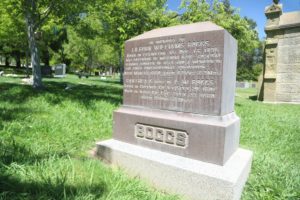
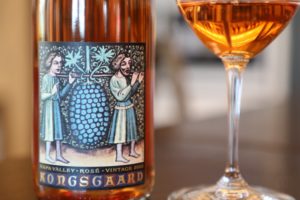
 Kongsgaard Wine – A cave shrouded in silence is perhaps the ultimate studious environment to work within an underground winery. A cave with classical music playing quickly changes the atmosphere and ties the science of winemaking into the art of winemaking. Judging by John Kongsgaard’s large collection of CDs in the wine cave – his work here is seldom done in silence. In getting to know John, you will quickly discover music and mountain vineyards are two of his passions.
Kongsgaard Wine – A cave shrouded in silence is perhaps the ultimate studious environment to work within an underground winery. A cave with classical music playing quickly changes the atmosphere and ties the science of winemaking into the art of winemaking. Judging by John Kongsgaard’s large collection of CDs in the wine cave – his work here is seldom done in silence. In getting to know John, you will quickly discover music and mountain vineyards are two of his passions.
He is a fifth generation Napan; his roots run deep in the valley, supported by a fascinating history. Through his mother’s side (Lorrain), John’s great grandfather Lilburn Boggs was Governor of Missouri and moved west, settling in the town of Sonoma in 1846 and working for General Mariano Vallejo (he lived at the General’s adobe house in Sonoma) and eventually retired to the city of Napa. For some historical perspective, the first person of western heritage to live in the Napa Valley was George Yount in 1838. The first commercial vintage of wine produced in the Napa Valley was at Patchett Cellars in the city in 1857.
John is also a direct descendant of explorer and adventurer Daniel Boone.
John’s grandfather Albert G. Streblow founded Basalt Rock Company in 1920, a stone quarry in Napa across from what is now the Napa Valley College. Until 2022 it was Syar Industries; today the quarry is owned by Vulcan Materials. His quarry provided the rock used to help build Treasure Island in San Francisco. John’s father Thomas was a Napa County Superior Court judge for more than twenty years; the downtown Napa Post office was named after him in 2011 – unfortunately it suffered severe damage in the 2014 Napa earthquake and remains closed to the public with plans already in place to convert it into a fancy resort.
John grew up as he says, “on the edge” of the wine industry in Napa. When he graduated high school in the late 1960s the number of active wineries in Napa was counted in the “teens”. He attended Napa Valley College for a year and a half before transferring to UC Davis. Within a few years after graduating from UC Davis with a master’s degree in viticulture and enology the number of wineries had more than doubled in the valley. Jobs for newly trained winemakers were plentiful and this was a time when Napa was truly at the forefront of greatness.
He briefly worked at long time Spring Mountain Chardonnay producer, Stony Hill in the 1970s, two harvest at the Christian Brothers, the 1976 harvest at Stag’s Leap Wine Cellars (only four years after their founding) but his first extensive wine making job was at Newton Vineyards where he worked from 1983 to 1996. He was the first winemaker in California to make and promote an unfiltered commercial white wine. He began Newton’s unfiltered Chardonnay program – today that wine is highly sought after. John was one of the first three students in California of Bordeaux based master blender Michel Rolland – the other two being Napa winemaker Zelma Long and Harlan Estate proprietor Bill Harlan. At the time Michel did not speak English so their language of communication was in Spanish.
While working at Newton John had the privilege of visiting and researching some of the most prominent wine regions in France. During one of his trips, he had a revelation about where the pH needs to be in some of his wines as well as wine style. This came after tasting through a number of wines from the mid 1940’s from some of France’s most prominent producers (first growths).
John’s wine making style is decidedly European influenced – he considers Michel Rolland to have had a huge influence on his career and especially on his style of white wines.
John and Maggy (died in 2020) Kongsgaard purchased their Atlas Peak property in 2004; they are only the second owners since the original homesteader. The property rises high above the valley floor and the surrounding foothills of the Vaca Mountains. Their vineyard is one of the three highest vineyards in all of Napa County; the other two are the Merryvale owned Altezia Vineyard on Mt Veeder and the Blue Ridge Vineyard in the southeastern part of the county which tops out at 2810 feet. Kongsgaard’s uppermost vines are planted at slightly more than 2500 feet and the winery itself is at 2300 feet which is certainly among the highest wineries in the Napa Valley.
The property is 150 acres of which most is still in its natural state on rugged and often steep hillsides. Only five acres are currently planted including to Cabernet Sauvignon, Cabernet Franc, Viognier and Roussanne. This is a property with truly spectacular views from any number of directions. On a clear day in the wintery looking to the east, you can see the snowcapped Sierra Nevada mountains rising far in the distance (just north of Lake Tahoe) and also south into the central valley. In the other direction you see a patchwork of vineyard blocks covering the Napa Valley floor far below. In between are major wine estates with several thousand acres between them, Antica Napa Valley (run by one of the world’s five oldest family businesses) and Stagecoach, one of Napa Valley’s largest vineyards.
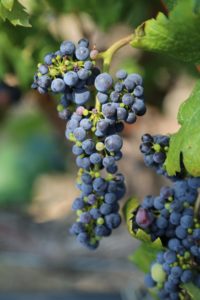
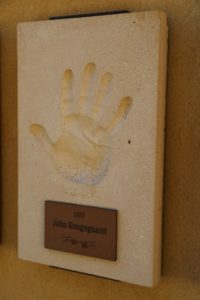 The Red Aiken loam soils on the property are unique as these are the southernmost extension of the red rocky iron rich volcanic soils that make up the ground in the hills above the eastern part of Oakville and Pritchard Hill. It is unusual to see huge red stained boulders lining the vineyards in this part of Atlas Peak – this is more akin to what we’ve seen on Pritchard Hill further to the north. Directly to the south of Kongsgaard’s property the hills drop in elevation dramatically and the soils in contrast at the lower elevations are fairly white, composed of a volcanic ash-like material called tufa. While seemingly a long way from the Pritchard Hill part of Napa (and it is when there are no connecting roads) – it is only about a two-hour hike from John’s property to one of his closest winery neighbors in Pritchard Hill, Ovid Winery.
The Red Aiken loam soils on the property are unique as these are the southernmost extension of the red rocky iron rich volcanic soils that make up the ground in the hills above the eastern part of Oakville and Pritchard Hill. It is unusual to see huge red stained boulders lining the vineyards in this part of Atlas Peak – this is more akin to what we’ve seen on Pritchard Hill further to the north. Directly to the south of Kongsgaard’s property the hills drop in elevation dramatically and the soils in contrast at the lower elevations are fairly white, composed of a volcanic ash-like material called tufa. While seemingly a long way from the Pritchard Hill part of Napa (and it is when there are no connecting roads) – it is only about a two-hour hike from John’s property to one of his closest winery neighbors in Pritchard Hill, Ovid Winery.
Because of their location and elevation, bud break, bloom and set are always behind the vines on the valley floor. However, growth catches up quickly as because of their elevation during late spring and summer an inversion layer sets in. Often in the early morning the temperature is much higher than the valley floor below – where fog can sit until mid-morning. The temperature is moderate here in the summer, rarely too hot or cold – allowing for even ripening. The elevation ensures they have plenty of sunshine hours.
And while the summit of Atlas Peak is 2,671 feet, there are no immediate vines in the vicinity of its peak. This vineyard is the highest on Atlas Peak with vines topping out at 2,447 feet. GPS coordinates of the highest vines: 38.43934, -122.25227. Kongsgaard is the third highest vineyard in Napa Valley.
The highest vineyard site in Napa County is the Harris Blue Ridge Vineyard planted to Zinfandel; their highest vines are at an elevation of 2,742 feet and are located on the Napa/Solano County line. GPS coordinates of the highest vines: 38.4121411, -122.1149301. The vast majority of this site is in Napa County with a very small section crossing the county line into Solano. We say vineyard site, because this property got hit hard in the LNU Lightning Complex fires of 2020 and we are not sure the vineyard is still being maintained. We will make a trip back up here sometime in spring 2025 to verify.
The second highest vineyard in Napa Valley is Altezia, owned by Merryvale (formerly Lampyridae Vineyard) with vines topping out at 2,625 feet near the summit of Mt. Veeder with the majority of their blocks above 2,500 feet. GPS coordinates of the highest vines: 38.37474, -122.44605.
The highest vineyard on Howell Mountain and perhaps the 4th highest vineyard in Napa Valley is Black Sears Vineyard which tops out at 2,396 feet. GPS coordinates of the highest vines: 38.60157, -122.47217.
The highest vineyards on Diamond Mountain are around 2,200 feet. And the highest vineyards on Spring Mountain are under 2,200 feet. We have personally visited each of these vineyards. We pulled the above numbers by hovering over all parts of these high elevation vineyards until we located the highest vines – using CalTopo.com
The vineyards that John sources from to make his current wines are all extremely low yielding – often around merely a ton per acre.
Wines + Winemaking
The first vintage of Kongsgaard dates from 1996; today John makes two Chardonnays including a Napa Valley bottling and one from his Judge Vineyard. In addition, he makes a blend of Viognier and Roussanne and a Syrah. Their production is limited to what John and his son Alex can comfortably make; currently it is around 3,000 cases annually.
Rosé/Whites
Rosé
The 2022 Kongsgaard Rosé of Syrah is deep copper in color; the bouquet offers aromas of orange peel, rose petals, pomelo and a hint of dried oregano. Minerally across the palate, this wine shows a lovely balance, complemented by some weight. The palate sports flavors of orange drop candy, white nectarine, raspberry and mandarin orange. Lingers with a perceived sweetness similar to eating dried dill seeds or anise. This is clearly a textural rosé, showcasing the classic Kongsgaard mouth feel with a supple and saline rounded texture but without being viscous. Not one aspect of this bottling stands out, and that is the hallmark of a balanced wine. Drinks easily.
Albariño|
The Kongsgaard Albariño is from the Hudson Vineyard in Carneros. This is the lowest pH wine they produce; it never goes through malolactic fermentation. And it is a variety that is not very resistant to oxidation, so their challenge is always how to get the SO2 to ‘stick’. This wine is fermented and aged in clay amphora.
The 2021 Kongsgaard Albariño Napa Valley is medium gold in color; minerally the nose reveals scents of honeydew melon, orange blossom, white nectarines, kumquat and a hint of dill and chamomile showing up towards the end of the bouquet. The minerally character on the bouquet is echoed on the palate. This is a rich but balanced expression of the variety with flavors of crenshaw melon, mandarin orange, stone fruits including peach, apricot and yellow nectarine, freshly cored Honeycrisp apple, pineapple, and comise pear. Lightly fleshy in texture, its brightness outshines its texture. Sometimes Albariño persists with a slightly bitter nuance; there is none of that in this wine. Lingers with a continued burst of flavor on the finish. We would love to pair this with fish that tends to be on the fattier side to help cut through the intensity of the wine – perhaps wild caught salmon grilled on cedar plank would do the job.
Chardonnay
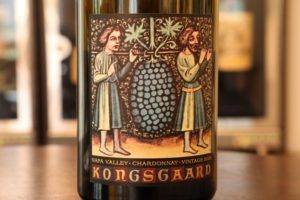 The making of a Kongsgaard Chardonnay is a lesson in patience. John sources fruit from vineyards low in nitrogen and low yielding. Low nitrogen can be a deterrent to fermentation so they add a natural yeast supplement during fermentation, but no DAP. They send samples of the juice to ETS Laboratories in St. Helena for the YAN data (yeast available nitrogen). He barrel ferments the wine; some of his fermentations take up to a year to complete to dryness and sometimes the malolactic fermentation finishes before the primary fermentation. He does not inoculate with commercial yeast and like his work at Newton, his wines are bottled unfiltered. He keeps his use of sulpher to a minimum and the wines spend two years in barrel in approximately 70% new French oak, oxidizing slowly while forming some aldehyde characters. Since Alex has become more involved in the winemaking, the amount of new oak has decreased. John describes the wine’s time in the barrel as, “wandering off into the oxidative wilderness”. Prior to bottling it is racked from its gross lees; he has never had to filter one of his Chardonnays.
The making of a Kongsgaard Chardonnay is a lesson in patience. John sources fruit from vineyards low in nitrogen and low yielding. Low nitrogen can be a deterrent to fermentation so they add a natural yeast supplement during fermentation, but no DAP. They send samples of the juice to ETS Laboratories in St. Helena for the YAN data (yeast available nitrogen). He barrel ferments the wine; some of his fermentations take up to a year to complete to dryness and sometimes the malolactic fermentation finishes before the primary fermentation. He does not inoculate with commercial yeast and like his work at Newton, his wines are bottled unfiltered. He keeps his use of sulpher to a minimum and the wines spend two years in barrel in approximately 70% new French oak, oxidizing slowly while forming some aldehyde characters. Since Alex has become more involved in the winemaking, the amount of new oak has decreased. John describes the wine’s time in the barrel as, “wandering off into the oxidative wilderness”. Prior to bottling it is racked from its gross lees; he has never had to filter one of his Chardonnays.
The 2022 Kongsgaard Chardonnay, Napa Valley is made from grapes sourced from two of Carneros’s iconic vineyards, Hudson and Hyde and from a vineyard in Coombsville planted by Warren Winiarski. This wine is medium to deep gold in color; the bouquet offers plenty of aromatic depth focusing on aromas that are a result of California sunshine. Its profile pulls as much out of this variety as possible from both the vineyard and in the cellar while retaining its overall balance and freshness. The bouquet reveals scents of baked apples, glazed pineapple, honeycomb, apricot, peaches in light syrup, mango, butterscotch and creme Brule. The palate offers ripe orchard fruits including of apricot and yellow nectarine along with baked pineapple, baked pears, toasted almonds, citrus oil and a chalky/minerally character persisting on the finish. Its texture is rounded but not fleshy and is accompanied by a balanced acidity. This bottling is the definition of balance – an attribute we don’t often associate with California Chardonnay.
The 2020 Kongsgaard Chardonnay, Napa Valley is medium to dark golden in color; the aromatics offer a honeyed note along with both stone and tropical fruits including yellow peach, apricot, pineapple, mango and lemon curd. Besides all the fruit on the bouquet there are some underlying layers of desserts spices and sweeter aromatics including of vanilla wafer and caramel. To some extent the flavors mirror the bouquet including of peach, apricot and lemon meringue pie. This wine’s texture is a noteworthy characteristic and offers a creamy and rounded feel across the palate. It also shows flavors of crème Brule, warm popcorn butter and caramel. The finish lingers rich with flavors of stone fruit, red apple and some citrus characteristics. This Chardonnay is balanced between its intense flavors, texture and acidity; it is hard to put down once one starts drinking it. This wine spent 22 months in barrel before it was bottled.
The 2009 Kongsgaard Chardonnay, Napa Valley is sourced from both the Hyde and Hudson vineyards in Carneros. Aromatically this wine shows apricot, a toasted nuttiness, slight tropical notes and a hint of caramel. Despite sitting in oak for 2 years John has crafted this wine so that as he says, “the wood is on the horizon” or in the background. A big part of the reason these wines are not “oaky” is the intensity of the particular fruit he works with – it can certainly stand up to the oak. Another reason for this is the wine sits on the lees for the first-year building weight but not woodiness. The wine shows a richness and sweetness of fruit (totally dry) along with mineralities on the palate without being too heavy. The finish is surprising; this wine waits to make an impact with the fruit at the end rather than on the entry of the palate. It is lively, zesty and has great length; it is somewhat tropical along with lemon and lime notes.
The Judge is named in tribute to John’s father and is from the family’s Stonecrest Vineyard property just northeast of the city of Napa; today this vineyard is owned by Alex Kongsgaard. John planted the first Chardonnay grapes here in 1975 when one of his neighbors, who just happened to be influential winemaker André Tchelistcheff, suggested this variety would grow well here. John remembers André used to drink martini’s with John’s father and described looking out over an empty horse pasture and thinking this land would be ideal for Chardonnay.
They used to grow small amounts of Zinfandel and Cabernet Sauvignon here, but ultimately neither variety was a good fit for this land. John describes Chardonnay as having the ability to still function as a cripple in a way that most varieties are unable to. The original cuttings of Chardonnay came from Stony Hill and included both Wente and Wente shot clone selections; the shot clone description refers to little tiny seedless grapes in clusters with normal size grapes. Another clone called Rood came from Sonoma County. John describes himself as a romantic collector of budwood. Remarkably some of the original Chardonnay vines planted here in 1975 are still growing; these are some of the oldest Chardonnay vines in Napa Valley. When they need to replant, they test vines for virus and take cuttings from the cleanest of the vines.
The property was originally intended to be a quarry site for John’s grandfather; one can see his intent when walking this extremely rocky vineyard. The soils are off white pink and composed of decomposed volcanic ash. John calls their composition chemically esoteric. The stunted vines produce only about a ton per acre each year. They grow quickly in the first 5 years but then due to the rocky conditions and limited nutrients, their subsequent growth becomes extremely slow. They are planted three feet apart.
Stonecrest supplied Newton with the grapes for their unfiltered Chardonnay for many years.
The 2019 Kongsgaard Chardonnay, The Judge; this wine is deep gold in color; fully ripe and deeply layered the bouquet offers scents of honeycomb, butterscotch and plenty of ripe orchard fruits including apricot, yellow peach, baked golden delicious apples, vanilla, caramelized sugars including creme Brule and glazed pineapple, an aroma that reminds us of Pineapple upside down cake, our favorite dessert that we enjoy once a year on our birthday. The first flavor we noted on the palate is strongly honeyed, accompanied by plenty of stone fruits, mimicking the bouquet including apricot, peaches in light syrup, yellow nectarine, baked pineapple and apple pie. Incredibly rich, concentrated and layered both in terms of flavor, acidity and texture, the extended finish lingers with butterscotch, creme Brule, caramel and toasted nuts including almond and hazelnut.
The 2009 Kongsgaard Chardonnay, The Judge; this wine is deep gold in color and noticeably darker in the glass than the Napa Valley Chardonnay. It is both refined aromatically yet also highly expressive of ripe and layered fruits – pulling all one can possibly pull from both the variety and California sunshine. The palate shows stone fruits including white peach and white nectarine; the mouth feel is oily, viscous and rich. It has mineralities; John takes this description a step further and describes it as “salty, almost briny” in feel. This wine will age – with a track record of Chardonnay from the Judge vineyard going back more than thirty years John has noticed that the wines will typically keep their classic characteristics (continuing to evolve in the bottle of course) for five to eight years before reaching a plateau.
In 2021 for the first time, Kongsaard produced a truly special Chardonnay, a single barrel, four year aged Chardonnay that was bottled exclusively in magnums.
VioRous
The 2010 Kongsgaard Viognier and Roussanne blend is cleverly called the VioRous. The Roussanne ripens and then is allowed to ripen even further – allowing the skins to turn a beautiful bronze color. The Viognier is slower ripening and once it is fully ripe, both varieties are picked simultaneously and then co-fermented. Borrowing from John’s musical interests, he describes this wine as having “a chorus of flavor”. It might as well have a chorus of aroma. The bouquet is highly and floral with scents of iris and jasmine and white peach. Rather than the two years of age, this wine was aged in older oak for a year. The showcase of this blend is all about the fruit; it is opulent and ripe. Both Roussanne and Viognier are among the more “tannic” of the white varieties and you can clearly sense the structure in this wine, especially with the lingering tannins on the finish.
While Kongsgaard no longer produces VioRous, starting in 2022, Kongsgaard produced their first Estate White Blend. This is a co-fermented blend of Viognier, Sauvignon Blanc, and Chardonnay fermented and aged in both clay amorpha and old French oak barrels.
Reds
The 2019 Kongsgaard The Fimasaurus Napa Valley Red Wine is an equal 50% blend of Merlot and Cabernet Sauvignon; the grapes are harvested at the same time and co-fermented in 100% new French oak barrels. The Cabernet Sauvignon comes from both the Kongsgaard estate and a neighboring vineyard about 500 feet lower in elevation that is managed by the Kongsgaards. This wine is deep ruby; the bouquet smells like the variety which isn’t always the case in contemporary Napa Valley. Its scents include red chili spice, jalapeno, dried tobacco leaf, old cedar box, thyme, dried sage and rose stems, an aromatic that was first described to us by Opus One winemaker, Michael Silacci. We will point out that we didn’t lead our aromatic descriptions with fruit. This is a savory showing of the variety rather than a fruit driven expression. If we were to pick out a singular fruit aroma it would be spicy Satsuma plum skin. The palate is vibrant, red fruited and herbal. Its flavors include cherry, plum, currant, cranberry, sage and thyme with a note of jalapeno pepper and red chili. The lightly textured tannins are silky and linger with a light chalky character; John describes its beautiful texture as a perfect suit where one doesn’t notice the shoulder pads. This wine is bright and built to age. Its name is in homage to one of John’s friends, a Russian pianist. .
John has worked with Carneros growers Lee Hudson and Larry Hyde since the 1980s and continues to source from from both their vineyards. John came up with the concept in the 1980s (now more common when contracting premium vineyards) to pay by the acreage rather than the ton and as he says, “this effectively turned a grower into a winemaker”. Quality becomes the focus rather than quantity.
His Syrah comes from a special 2.5-acre block in the Hudson vineyard that is not composed of the typical claylike uplifted ocean bottom soils that is common in Carneros. Rather this tiny block has slight elevation and is in the foothills of Mt. Veeder; its soils are made up of volcanic ash. Such is the nature of this variety and particular vineyard that it is their most expensive to manage. Their Syrah is 100% destemmed and aged in 50% new French oak barrels. John finds Syrah can be vulnerable in terms of too much oak. He uses Darnajou for aging this wine; Kongsgaard was the first winery to use Darnajou barrels in Napa Valley; John was introduced to this cooper by Bordeaux based winemaker Michelle Rolland
The 2013 Kongsgaard Syrah Carneros is deep ruby and opaque; we tasted this wine 12 years post vintage. The bouquet offers an attractive union of ripe cherry, tobacco spice and dried herbs. Beautiful. Its aromas also include tomato leaf, dark plum, blackberry, white pepper and rosemary. John attributes the aromas and flavor to the cold-climate of Carneros and the fact its bottle age is starting to reveal its aromatic charm. This wine is highly expressive and aging extremely every well. In a blind tasting we would never have guessed its age as a decade plus. Never. Fresh, layered, lively and bright. Full of energy. On the palate there are flavors of plum, cherry, cranberry and dark raspberry with lasting notes of crushed pepper corn, smoked sage and a persistent dusty character. The still youthful tannins are grainy, gritty and fully coating. Chewy. Both fruit and texture continues to persist in tandem on the extended finish. This wine has loads of life ahead; we would love to try this again in 15 years.
The 2009 Kongsgaard Syrah. This is an example of a cool weather Syrah where one can get lost in the layers of aromatic diversity on the bouquet. The aromas are highly floral with both dried and fresh rose petals. And the nose shows subtle hints of white pepper, a dustiness and roasted meats. The palate is about the black fruit. Bright acidity runs the length of the palate, and is especially noticeable on the finish; this wine is mouthwatering and salivating because of its natural acidity.
Kongsgaard is no longer producing a Cabernet Sauvignon.
—
With Kongsgaard’s vineyard perched at the highest reaches of Atlas Peak and with its south and west facing exposure their highest plantings receive the last rays of sunshine over the Napa Valley most every day in the summer. The development of this property is the culmination of John’s experience built upon his thirty plus years in the valley and with his son’s involvement in the winemaking – a lasting gift for his future generations.
Besides winemaking, John oversees Chamber Music in Napa Valley, a non-profit organization which was founded in 1980 by Dick Lemon with support from Clos du Val Winery. Barney and Belle Rhodes were early supporters. Chamber Music in Napa Valley hosts a variety of concerts and distinguished musicians each year; early concerts were held in the caves at what was S. Anderson Winery, currently the home of Clif Lede Winery. Today they are held in the city of Napa at the First United Methodist Church. Performers have included pianist Emanuel Ax, conductor Jeffrey Kahane and the Juilliard Quartet. Subscription based, these affordably priced events are open to residents of Napa and Sonoma counties. Tickets for individual concerts are available through a waiting list.
With John’s love for music, he is quick to state, “our wine has a strong presence surrounding European opera houses”. Makes sense. After performances, artists and concert goers often frequent local cafes. However, most of their wine is sold via a onetime per year release via their mailing list (which sells out quickly). Other select distribution includes in twelve states (restaurants) and several countries both in Europe and Asia. Locally one can find their wine in a number of Napa Valley’s finest restaurants including Bottega in Yountville and several wine shops including V Wine Cellars and Oakville Grocery. One will more likely find the Napa Valley Chardonnay available in distribution rather than the highly coveted and limited production, The Judge Chardonnay.
—
For more information and to join their mailing list visit: www.kongsgaardwine.com

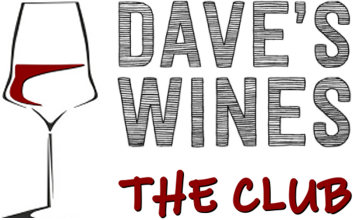




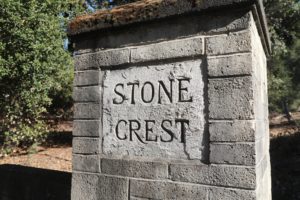
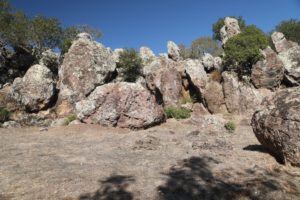
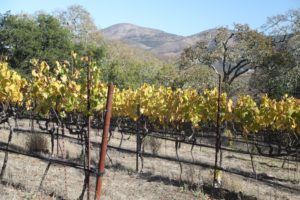
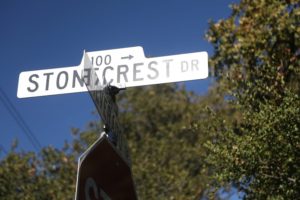
Leave a Reply